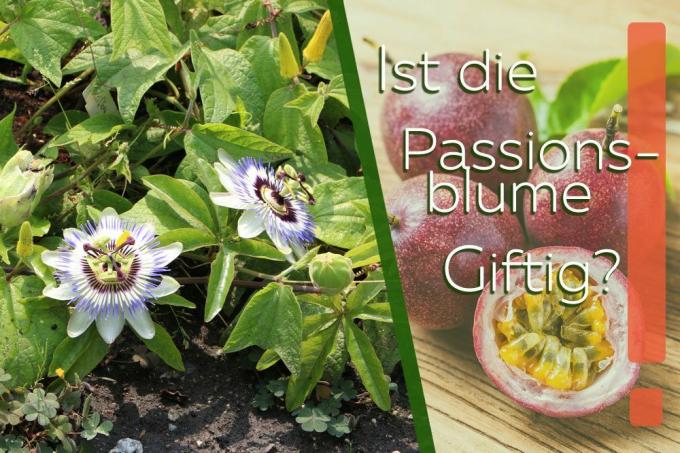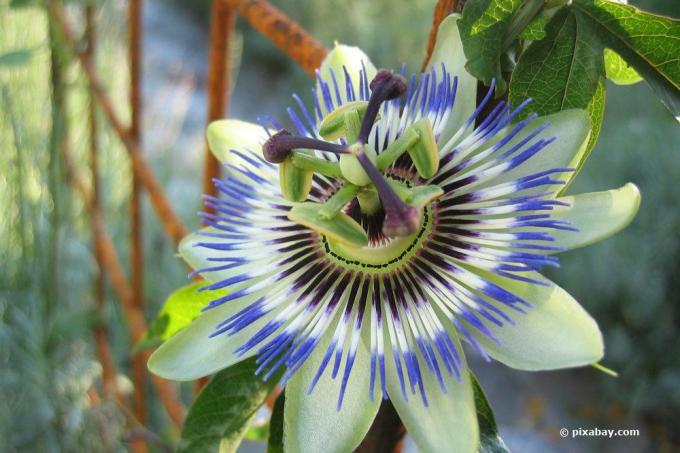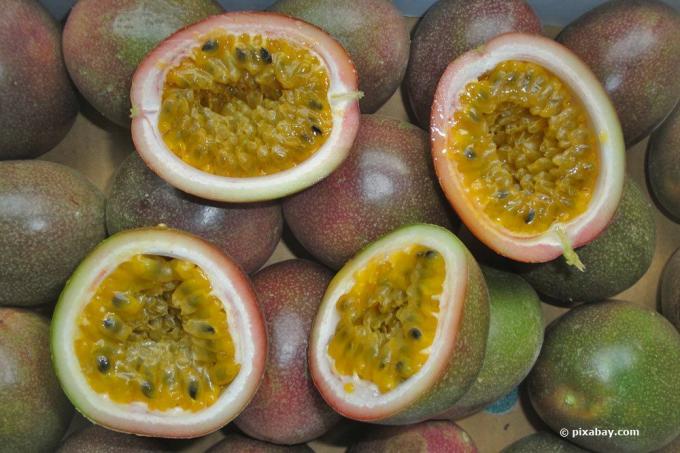
table of contents
- Passion flower poisonous or not?
- Symptoms of intoxication
- First aid
- Medicine
- Edibility of passion fruit
Passion flowers (Passiflora) are popular house and ornamental plants in this country. They come in a wide variety of shapes and colors. The striking, exotic, magnificent flowers are particularly appealing. The Passiflora is persistent and is usually grown as a climbing plant. There are over 530 different species worldwide. However, numerous other hybrid varieties have emerged through breeding. Often, however, the question arises whether the Passion flower and their fruits contain toxic components? More on this below.
Passion flower poisonous or not?
There have been contradicting statements about the toxicity of the passion flower. This plant is divided into four subspecies, whereby the subgenus Decaloba with its 220 representatives is slightly to severely poisonous. In addition, other passiflora species also contain a more or less high proportion of hydrocyanic acid. The concentration varies. Mainly the toxin is in
- the drives
- Scroll and
- Contains unripe fruits.
The most widespread are the blue (Passiflora caerulea) and the flesh-colored (Passiflora incarnata) passion flower. Investigations here showed that the parts of plants and fruits of the blue passiflora do not contain any toxic substances. On the other hand, the toxicity of the flesh-colored passion flower has not yet been fully clarified.
Note: Hydrocyanic acid is a highly toxic substance, also known as hydrogen cyanide. By absorbing the poison, an enzyme is inhibited in the body, which is required for the cells to breathe.

Symptoms of intoxication
After consuming parts of the passionflower plant, different symptoms can occur. These depend on the amount of hydrocyanic acid absorbed. Even a small concentration of the poison of 1 to 2 milligrams per kilogram of body weight (The tolerance range is between 1 and 60 milligrams per kilogram of body weight) can, however, be fatal Have consequences. Because even a small amount can lead to a lack of oxygen.
tip: Consumption of the plant parts is not recommended. The plant should always be kept out of the reach of small children and pets so that they have no contact with the Passiflora.
Depending on the amount of poison ingested, the most varied of symptoms can occur:
- Scratchy throat
- Dizziness
- headache
- Circulatory problems
- nausea
- Vomit
- increased salivation
- cramps
- general weakness
- Lack of oxygen
In the worst case, the central nervous system is first excited by the hydrocyanic acid, then paralyzed and this can lead to respiratory paralysis.
Note: The passion flower is also known as "passion flower". The structure of the flower stands as a symbol for the passion (story of suffering) Jesus on the cross. The crown-like, white-blue wreath of flowers represents the crown of thorns of the crucified.
First aid
Although, after ingestion of poisonous parts of the passionflower plant by healthy adults, it is usually not severe Poisoning is to be expected, poisoning in small children and pets, due to their low body weight, can be fatal get lost. Mainly cats, rabbits and other rodents are at risk here.
Nevertheless, it should be used if symptoms occur, especially in children
- the emergency number 112 was dialed
- an emergency doctor requested and
- at the same time information at the Poison Control Center be obtained.
In the case of animals with symptoms of poisoning, the veterinarian should be contacted.
tip: It is also advisable to always wear gloves when working on the passion flower.
Medicine
The Native Americans already used plant parts of the Passiflora in medicine. Only the leaves and stems of Passiflora incarnata (flesh-colored passion flower) are used. Due to its drug-like effect, it is used in phytotherapy (herbal medicine) in the form of tea, capsules, in high doses as an extract in drops and juices or as a combination preparation with valerian, St. John's wort, hops, hawthorn or Lemon balm. These preparations provide relief
- nervous restlessness
- Tension
- irritability
- Anxiety
- insomnia
- Back pain
- Tension
- Heart trouble
- Stomach and intestinal discomfort
- depressive moods
- Hysteria and
- asthma

tip: For tea, brew 2 g of freshly cut cabbage with 150 ml of boiling water, let it steep for 5 to 10 minutes and then strain. A cup two to four times a day promotes wellbeing. If you have trouble sleeping, drink a cup half an hour before going to bed.
Beware of side effects
No preparations with additives of passion flower should be consumed during pregnancy. So far, however, not all side effects have been fully clarified. It can
- sometimes to allergic reactions
- sleepiness
- Drowsiness and
- Impairment of driving ability come.
Edibility of passion fruit
From a botanical point of view, the fruits of the passion flower are called berries. The fruits of 20 types are edible and also tasty. Depending on the type, they are as Passion fruit or Granadilla. The fruits are
- mostly egg-shaped with firm skin
- yellowish-green to brownish-red in color
- with yellow pulp and dark, edible seeds similar to pomegranate
The taste of the pulp and the yellow juice can be extremely sour, bitter or sweet, depending on the variety. It contains a lot of vitamin C. These exotic fruits are particularly popular with gourmets. The pulp is spooned out and eaten or can be processed into passion fruit juice.
Most often, however, the fruits of the real passion fruit (Passiflora edulis) are consumed. These are also known as purple granadilla or red passion fruit. In addition, other Passiflora species provide tasty fruits, for example
- the yellow granadilla (Passiflora edulis f. flavicarpa)
- the sweet granadilla (Passiflora ligularis)
- the banana passion fruit or curuba (Passiflora tarminiana) and also
- the king or giant granadilla (Passiflora quadrangularis)
In contrast, the taste of the fruit of the blue passion flower (Passiflora caerulea) is completely inedible.

tip: The fruits of the flesh-colored passion flower (Passiflora incarnata) can be processed very well into jams, jellies or fruit drinks. The flowers, on the other hand, are wonderful for making syrup.
Note: Please note that this article does not in any way replace a visit to the doctor. There is no guarantee that medical statements are correct.
You will find detailed information on first aid in the event of poisoning and important information on poison control centers here.
